New Year's Day trading consultation - economic impact and impact on family life: report
Report on economic impact and impact on family life relating to the New Year's Day trading consultation.
4. Impact of Covid-19 on the Retail Sector
While the Covid-19 pandemic is first and foremost a health crisis, it is has also had an unprecedented impact on businesses and the economy since March 2020. The public health measures introduced to contain the spread of the virus necessitated the temporary closure of many businesses during multiple lockdown periods and required others to restrict or change how they operate. As a result, impacts differed across sectors with non-essential retail stores (e.g. clothing) required to close for prolonged periods. On the other hand essential retail (e.g. food) were allowed to trade and saw increased output throughout this period (see monthly GDP data in Section 3). Businesses that were able to trade online will have also had an advantage. These varying impacts should be noted as the following data cannot be broken down to compare these retail sub-sectors.
Business Insights and Conditions Survey (BICS)
The Business Insights and Conditions Survey (BICS) is a UK-wide fortnightly business survey, published by the Office for National Statistics (ONS), that captures businesses' responses on how their turnover, workforce, prices, trade and business resilience have been affected by the Coronavirus pandemic over two week reference periods. The results in this note relate to wave 40 of the survey covering the two week period 20 September – 3 October 2021.
The results for Scotland presented here have been weighted using the Office of the Chief Economic Adviser's (OCEA) own weighting system to be more representative of the business population in Scotland. Note that in some cases the weighted data for Scotland cannot be compared to the published UK data.
The data is for businesses with 10+ employees with a presence in Scotland. The coverage of micro businesses (1-9 employees) in BICS for Scotland is currently not robust. The results for Scotland, particularly the sectoral results, should be treated with caution given small sample sizes. Where possible, it is corroborated with other sources to test for robustness.
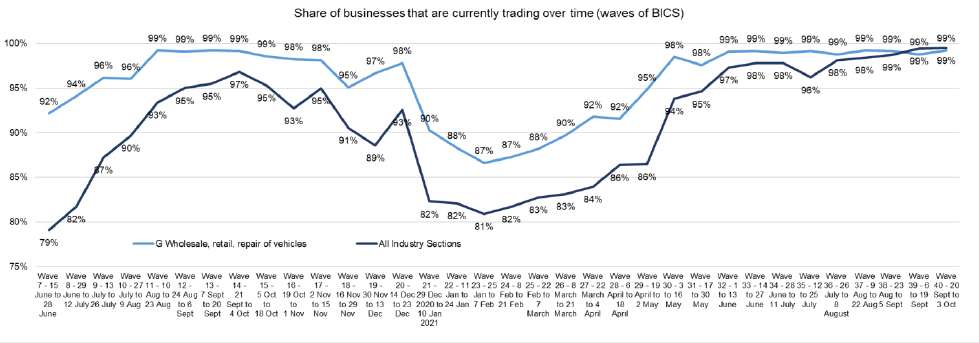
At the time of wave 7 of the BICS, when initial lockdown measures were still in place, 92% of wholesale, retail, repair of vehicles firms with a presence in Scotland were trading, above the average for all sectors (79%). The lowest point of activity for the wholesale, retail, repair of vehicles sector was during the nationwide lockdown at the beginning of 2021 when 87% were trading. Despite this, businesses in the wholesale, retail, repair of vehicles sector were more likely to continue to trade across all waves of the survey compared to all businesses in Scotland.
Almost all (99%) wholesale, retail, repair of vehicles firms were trading in the most recent wave (20 September – 3 October 2021) of the survey as non-essential retail restrictions eased in Scotland on 26 April 2021.
Turnover[18]
21% of wholesale, retail, repair of vehicles firms with a presence in Scotland reported that their turnover has decreased compared to what is normally expected for this time of year, lower than the average for all businesses (25%). 16% reported increased turnover. 46% of wholesale, retail, repair of vehicles firms reported that turnover has not been affected.
Over a third (35%) of wholesale, retail, repair of vehicles firms with a presence in Scotland reported that the main reason for their business's change in turnover is the Covid-19 pandemic. A quarter (25%) stated both the pandemic and the end of the EU transition period as the reason, and 18% stated other.
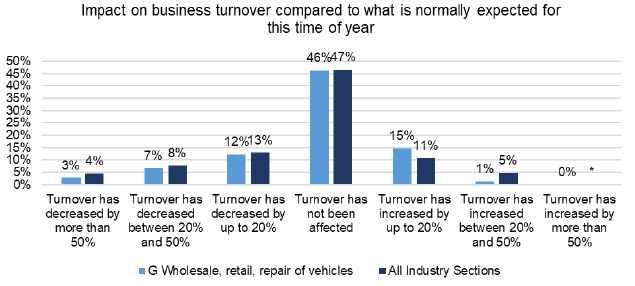
Across the period June 2020 to October 2021, businesses in the wholesale, retail, repair of vehicles sector have faced varying restrictions due to the Covid-19 pandemic which is reflected by the share reporting decreased turnover in the chart below. A peak of 56% wholesale, retail, repair of vehicles businesses reported decreased turnover during the national lockdown at the beginning of 2021. This has now fallen to a low of 21% businesses during the most recent wave of the survey (20 September to 3 October 2021).

Cashflow
14% of businesses in the wholesale, retail, repair of vehicles sector that had not permanently stopped trading reported having no or less than 3 months cashflow in the period 6 to 19 September 2021 (Wave 39[19]), compared with 22% for the economy overall. 2% reported having no cash reserves.
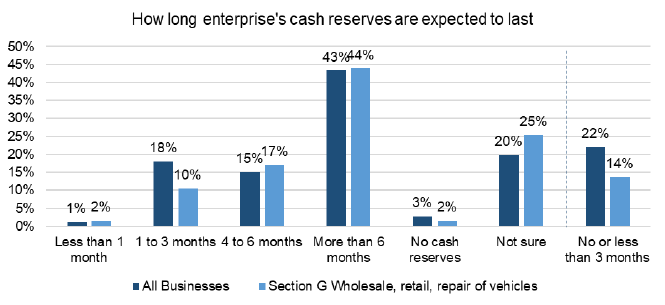
Staffing
Only 1% of the workforce were on furlough leave in wholesale, retail, repair of vehicles sector in the latest wave of BICS, for which we have robust data (Wave 39[20]), compared to 6% of ll businesses. This is a decline from 26% at its peak when Covid-19 restrictions were in place at the beginning of 2021 for non-essential retail.

7% of the workforce were working remotely for a business in the wholesale, retail, repair of vehicles sector compared to 18% of the workforce for all businesses.
Only 2% of wholesale, retail, repair of vehicles firms were expecting to make any of their workforce redundant over the next three months compared to 3% for all businesses.
Insolvency
5% of wholesale, retail, repair of vehicles firms with a presence in Scotland that had not permanently stopped trading reported to be insolvent or at least moderately at risk of insolvency in the period 6 to 19 September 2021 (Wave 39[21]), compared to 10% for all businesses. Wholesale, retail, repair of vehicles firms were less likely to be insolvent or at least moderately at risk of insolvency compared to all industries in the first lockdown in 2020, however this was reversed in the lockdown at the beginning of 2021.
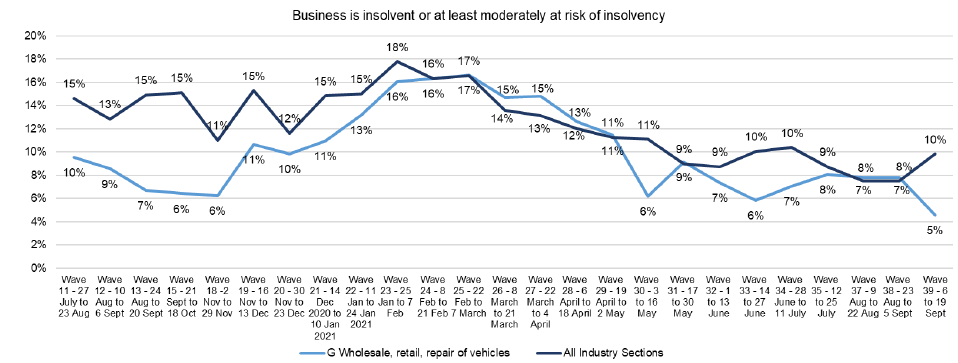
Impact on sales[22]
According to the Scottish Retail Consortium's (SRC) latest data the retail sector in Scotland is still experiencing low sales compared to pre-pandemic (prior to March 2020). Total retail sales increased by 1.3% in September 2021 compared to the previous year (September 2020). Total food sales in September 2021 increased by 0.4% as well as non-food sales that increased by 2.1% compared to the year before. On a two-year basis, however, total sales continued to perform below pre-pandemic levels with sales down 9.1% compared to September 2019.
Impact on retail footfall
SRC's Footfall Monitor shows that footfall decreased by 19.9% in September 2021 compared to pre-pandemic (September 2019), but saw an increase of 1.3% from August 2021[23]. The chart below shows the varying impact on footfall for the two retail sub-sectors (grocery & pharmacy stores vs retail & recreation) across the pandemic in the UK. The number of visitors to retail stores and recreation businesses over the pandemic saw a greater decline than grocery and pharmacy stores. This is because grocery and pharmacy stores were deemed essential during lockdown and could remain open. Other retail and recreation businesses will have therefore experienced lower footfall during this period.
On 1 January 2020 (New Year's Day), retail and recreation footfall was down 59% and grocery and pharmacy was also down 27% compared to pre-pandemic average. This was the second lowest point during the pandemic, however this will have been heavily influenced by nationwide lockdown restrictions imposed at the start of 2021 and will not reflect usual trading activity. It should also be noted that many businesses voluntarily closed on New Year's Day. Note: Google Mobility data is not available pre-pandemic and has been made available for Covid-19 analysis.
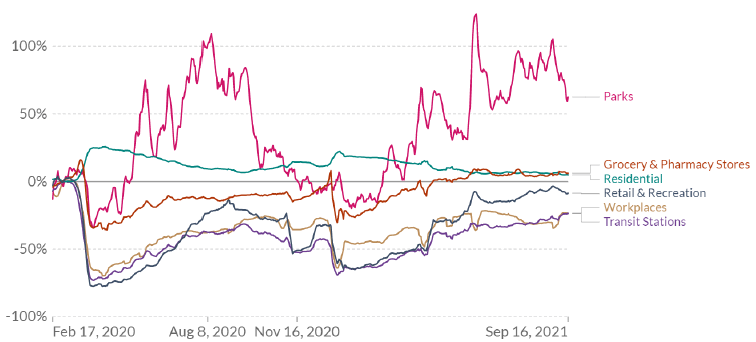
Source: Google Mobility data, September 2021
Impact on Online sales
The considerable impact of the Covid-19 pandemic on e-commerce activity has been evident. Due to lockdown measures, online retail sales as a percentage of total retail sales has seen record highs across the UK with a peak of 36.5% in January 2021. Online sales made up 25.9% of retailing in the UK in September 2021. Despite the recent decline, online sales are still significantly higher than February 2020's pre-pandemic levels. The chart below also shows the spike every November before Christmas 2020 when online sales' share of total retail sales is at its highest.
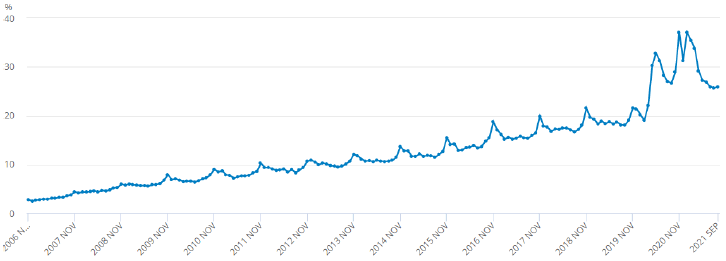
Source: ONS Retail Sales Index
Contact
Email: paula.cassells@gov.scot
There is a problem
Thanks for your feedback